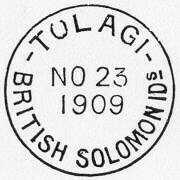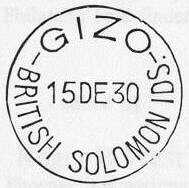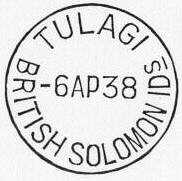 |
The Mysterious Madame Joseph |  |
|
|
||
|
|
||
|
Madame Joseph Forged British Solomon Islands Postmarks (Worboys) |
||
|
When retired dealer Derek Worboys first learned about the "appalling treasure trove" of forger's implements in the estate of George Santo, he knew that they must quickly be put in a "place of complete safety" before they could fall into unscrupulous hands. Santo had acquired the cancellation devices from the estate of a "rogue dealer" and kept them safely out of the hands of crooks for several years. Santo's son, Clive, was seeking a permanent repository for the devices. The price being asked for the cancellation devices was so high that a creative solution was required. Worboys and Roger West of Phoenix International hit on the plan of selling subscriptions to a handbook of the forgery types to raise the required sum. While many of the dealers they approached behaved as if they did not wish to see knowledge of the forgeries become widely available, they eventually secured the required backing, published the handbook, and deposited the items safely within the confines of the Royal Philatelic Society. The history of the collection is truly fascinating. In the 1930's, a "Madame Joseph" living in Paris produced the devices for London dealer Gordon Rhodes. Rhodes used the devices to "improve" heavily hinged and gumless stamps. Rhodes reportedly even offered next day delivery of such items to unsuspecting collectors who inquired after fine used stamps. In all, 438 devices are known to have been used, including special cancels for the 1935 Silver Jubilee and 1937 Coronation issues. After Rhodes' death, Cecil Jones, who inherited Rhodes' shop, apparently continued the forging (in part to pay his gambling debts) until the shop changed hands in 1960. The Madame Joseph collection includes the four devices for the British Solomon Islands shown above. The first forgery, with a date of November 23, 1909, could be found on Small Canoe Issues. Although there is reason to suspect that this cancel exists on the Large Canoe issue, its usage would not be contemporaneous, since Woodford reportedly had destroyed all remaining stock of the issue by March 23, 1909. However, suitable placement of the cancel on the stamp could obscure the year date. The Gizo and second Tulagi forgery could be found on George V Keyplate issues. The Lunga forgery could be found on the George VI Definitives. As a curious epilogue to this story, Worboys reports that between the fall of France in 1940 and its liberation in 1944, Madame Joseph used her considerable skills to forge documents used by the French Resistance in its struggle against the Nazi occupiers. "Indeed, some shot-down Allied airmen may well owe their lives and escape to Madame J." For more on this most interesting story, see Forged Madame Joseph Postmarks, by Derek Worboys. |



